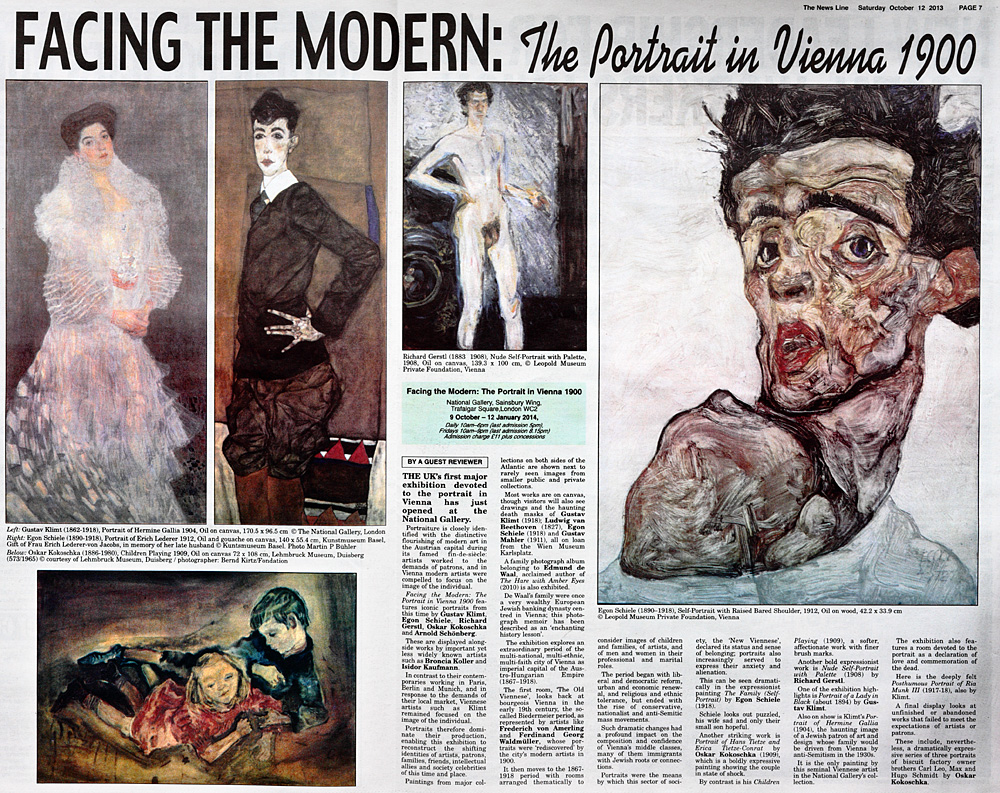The News Line Saturday October
12 2013 PAGE 7
FACING THE MODERN:
The Portrait in Vienna 1900
BY A GUEST REVIEWER
Facing the
Modern: The Portrait in Vienna 1900
National Gallery, Sainsbury Wing,
Trafalgar Square,London WC2
9 October -12 January 2014
Daily 10am-6pm (last admission 5pm)
Fridays 10am-9pm (last admission 8.15pm)
Admission charge 11 UK pounds plus concessions
THE UK's first major exhibition devoted to the portrait in Vienna has
just opened at the National Gallery.
Portraiture is closely identified with the distinctive flourishing of
modern art in the Austrian capital during its famed fin-de-siècle: artists
worked to the demands of patrons, and in Vienna modern artists were
compelled to focus on the image of the individual.
Facing the Modern: The Portrait in Vienna 1900 features iconic
portraits from this time by Gustav Klimt, Egon Schiele, Richard Gerstl,
Oskar Kokoschka and Arnold Schönberg.
These are displayed alongside works by important yet less widely known
artists such as Broncia Koller and Isidor Kaufmann.
In contrast to their contemporaries working in Paris, Berlin and Munich,
and in response to the demands of their local market, Viennese artists
such as Klimt remained focused on the image of the individual.
Portraits therefore dominate their production, enabling this exhibition to
reconstruct the shifting identities of artists, patrons, families,
friends, intellectual allies and society celebrities of this time and
place.
Paintings from major collections on both sides of the Atlantic are shown
next to rarely seen images from smaller public and private collections.
Most works are on canvas, though visitors will also see drawings and the
haunting death masks of Gustav Klimt (1918); Ludwig van
Beethoven (1827), Egon Schiele (1918) and Gustav Mahler
(1911), all on loan from the Wien Museum Karlsplatz.
A family photograph album belonging to Edmund de Waal, acclaimed
author of The Hare with Amber Eyes (2010) is also exhibited.
De Waal's family were once a very wealthy European Jewish banking dynasty
centred in Vienna; this photograph memoir has been described as an
'enchanting history lesson'.
The exhibition explores an extraordinary period of the multi-national,
multi-ethnic, multi-faith city of Vienna as imperial capital of the
Austro-Hungarian Empire (1867-1918).
The first room, The Old Viennese', looks back at bourgeois Vienna in the
early 19th century, the so-called Biedermeier period, as represented by
artists like Frederich von Amerling and Ferdinand Georg
Waldmüller, whose portraits were 'rediscovered' by the city's modern
artists in 1900.
It then moves to the 1867-1918 period with rooms arranged thematically to
consider images of children and families, of artists, and of men and women
in their professional and marital roles.
The period began with liberal and democratic reform, urban and economic
renewal, and religious and ethnic tolerance, but ended with the rise of
conservative, nationalist and anti-Semitic mass movements.
Such dramatic changes had a profound impact on the composition and
confidence of Vienna's middle classes, many of them immigrants with Jewish
roots or connections.
Portraits were the means by which this sector of society, the 'New
Viennese', declared its status and sense of belonging; portraits also
increasingly served to express their anxiety and alienation.
This can be seen dramatically in the expressionist painting The Family
(Self-Portrait) by Egon Schiele (1918).
Schiele looks out puzzled, his wife sad and only their small son hopeful.
Another striking work is Portrait of Hans Tietze and Erica
Tietze-Conrat by Oskar Kokoschka (1909), which is a boldly
expressive painting showing the couple in state of shock.
By contrast is his Children Playing (1909), a softer, affectionate
work with finer brush marks.
Another bold expressionist work is Nude Self-Portrait with Palette
(1908) by Richard Gerstl.
One of the exhibition highlights is Portrait of a Lady in Black
(about 1894) by Gustav Klimt.
Also on show is Klimt's Portrait of Hermine Gallia (1904), the
haunting image of a Jewish. patron of art and design whose family would be
driven from Vienna by anti-Semitism in the 1930s.
It is the only painting by this seminal Viennese artist in the National
Gallery's collection.
The exhibition also features a room devoted to the portrait as a
declaration of love and commemoration of the dead.
Here is the deeply felt Posthumous Portrait of Rio Munk III
(1917-18), also by Klimt.
A final display looks at unfinished or abandoned works that failed to meet
the expectations of artists or patrons.
These include, nevertheless, a dramatically expressive series of three
portraits of biscuit factory owner brothers Carl Leo, Max and Hugo Schmidt
by Oskar Kokoschka.
http://www.wrp.org.uk
|
